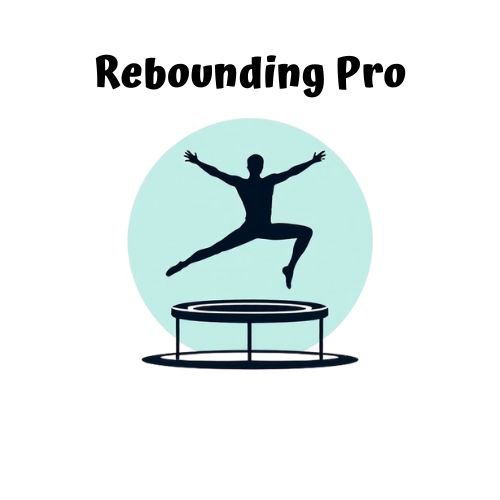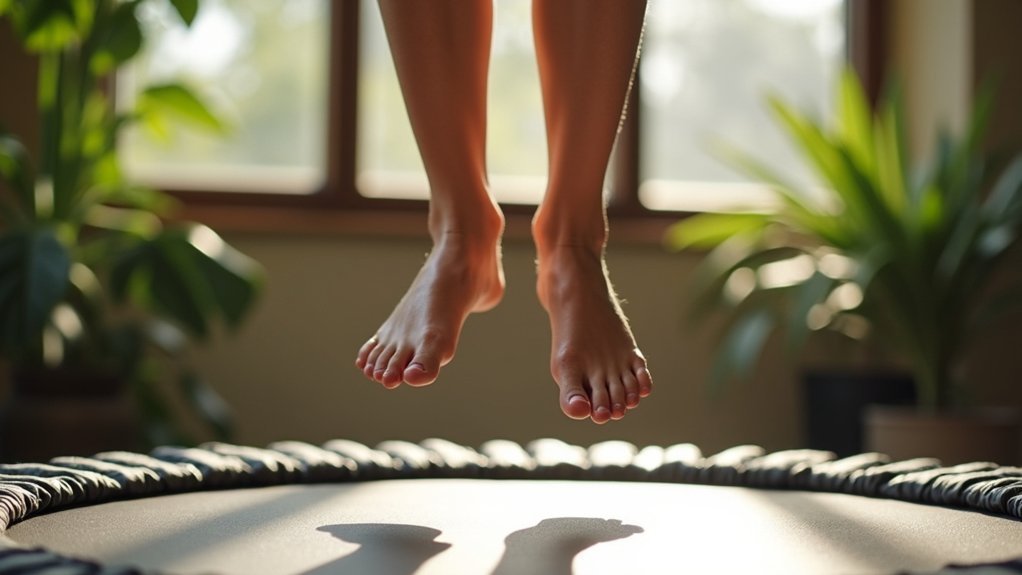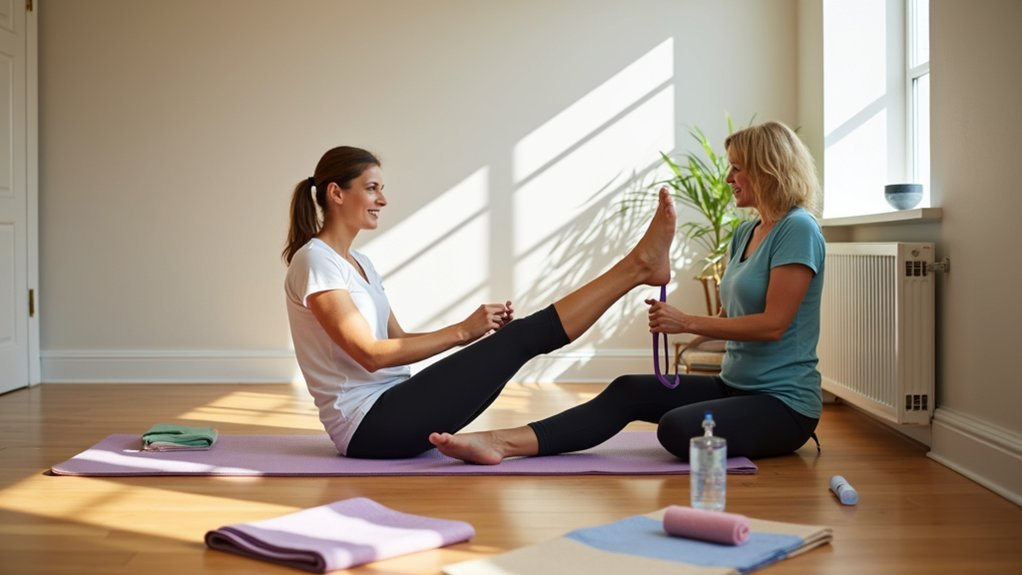Low-impact jumping exercises offer impressive benefits without harming your joints. You’ll build bone density, strengthen muscles, and improve cardiovascular health while experiencing mood-boosting endorphin releases. These accessible workouts suit all ages and fitness levels, making them perfect for family activities or rehabilitation. They’re metabolically efficient too—NASA found rebounding provides the same benefits as running in just one-third the time. Discover how these gentle bouncing movements can transform your physical and mental wellbeing.
Protecting Joint Health While Boosting Cardiovascular Performance

While many fitness enthusiasts gravitate toward high-impact exercises, low-impact jumping alternatives offer a powerful combination of joint protection and cardiovascular benefits.
You’ll experience considerably reduced stress on your ankles, knees, hips, and spine while still effectively elevating your heart rate. These exercises are particularly valuable if you’re recovering from an injury or concerned about long-term joint health.
Even in shorter 20-minute sessions, you’ll achieve extensive cardiovascular benefits without compromising joint integrity. You can easily adjust intensity based on your fitness level, making these exercises appropriate whether you’re a beginner or advanced athlete. These workouts are excellent for active rest days while maintaining physical engagement between more intense training sessions.
For those concerned about safety during workouts, low-impact jumping exercises provide an ideal balance—maintaining cardiovascular performance while minimizing injury risk, supporting joint health for years to come.
Building Bone Density Without High-Impact Stress
Although traditional wisdom suggests only high-impact activities build bone density, research shows low-impact jumping exercises offer significant bone-strengthening benefits without the accompanying joint stress. You’ll experience targeted strengthening precisely where you need it most—in the spine and femoral neck areas critical for fracture prevention. Jump training has been proven especially effective for improving bone density in the femoral neck, which is a common site for osteoporotic fractures.
| Bone Benefits | Implementation Tips |
|---|---|
| Increases lumbar spine and hip BMD | Just 10 jumps, 3 days per week |
| Stimulates bone formation without increasing resorption | Include 40-100 varied jumps per session |
| Creates site-specific strengthening | Rest between sets for ideal response |
The key to success lies in consistency and variety—incorporating different directions and intensities into your jumping routine. Even better, you don’t need hundreds of repetitions—brief exposures of 5-10 jumps can provide sufficient stimulus while maintaining safety for those with osteopenia or osteoporosis risk.
Muscle Strengthening Benefits of Low-Impact Rebounding

Your trampoline workouts strengthen fast-twitch muscle fibers by creating unstable conditions that demand rapid adaptation and contraction.
Core muscles, including your abdominals, back, and pelvic floor, are continuously engaged as you fight to maintain balance on the bouncing surface.
These strengthening benefits come with the advantage of up to 87% less joint impact than exercises performed on hard surfaces, making rebounding ideal for sustainable muscle development. Training on the unstable rebounder surface activates stabilizing muscles around your joints, enhancing both strength and balance simultaneously.
Fast-Twitch Fiber Development
Fast-twitch muscle fibers spring into action during explosive movements, making them essential for power-based activities in both sports and daily life.
Low-impact rebounding offers an ideal environment to develop these vital fibers without excessive joint stress.
When you perform quick, powerful movements on a mini-trampoline or with modified plyometrics, you’re effectively training your neuromuscular system to recruit fast-twitch fibers rapidly.
This translates to real-world benefits in:
- Explosive Power – Enhance your ability to generate force quickly, improving performance in jumping, sprinting, and reactive movements
- Neuromuscular Coordination – Develop better communication between your brain and muscles for more precise movement control
- Athletic Performance – Boost your speed, agility, and reaction time while maintaining joint health
The controlled environment of rebounding allows you to engage both Type IIa and IIx muscle fibers in a safer setting than traditional high-impact exercises.
Core Muscle Engagement
Consistently overlooked in standard fitness programs, core muscle engagement represents one of the most significant benefits of low-impact rebounding exercises.
When you bounce on a mini trampoline, your transverse abdominis, multifidus, and pelvic floor muscles automatically activate to maintain stability. These controlled movements strengthen your deep core muscles without straining your joints. Focusing on the mind-body connection during rebounding exercises enhances the effectiveness of your core engagement.
You’ll notice improved posture, better balance, and enhanced sport performance as your core stability increases. The gentle bouncing technique targets muscles that traditional exercises often miss.
For maximum benefit, focus on proper breathing while maintaining controlled movements. You can gradually increase intensity through progressive overload as your strength improves.
Many physical therapists recommend rebounding for rehabilitation because it strengthens core muscles while minimizing injury risk—making it ideal for all fitness levels.
Mental Wellness and Mood Enhancement Through Gentle Jumping
While many focus on the physical benefits of exercise, low-impact jumping provides remarkable advantages for mental health too. The rhythmic, repetitive motion of rebounding or jumping rope triggers endorphin release, elevating your mood and reducing stress.
You’ll notice improved mental clarity as these activities enhance blood flow to your brain while simultaneously decreasing cortisol levels. Activities like jumping rope can be particularly beneficial as it is a fun and easy exercise that promotes cognitive improvements while requiring minimal equipment.
- Just 10 minutes of gentle jumping can greatly boost your mood, decreasing symptoms of depression and anxiety while promoting emotional stability.
- The coordination required activates neural pathways, sharpening your focus and cognitive function.
- The playful nature of jumping exercises distracts from negative thoughts, builds self-confidence, and creates an immediate sense of accomplishment.
These mental wellness benefits make low-impact jumping a powerful tool for both physical and emotional health.
Accessible Exercise Options for All Fitness Levels and Ages

Low-impact jumping exercises shine in their remarkable accessibility across generations and physical conditions. Whether you’re a senior seeking joint-friendly workouts or someone recovering from injury, modified jumping activities on trampolines absorb impact while providing cardiovascular benefits.
For those with joint issues, trampolines offer a forgiving surface that reduces stress on the body while still delivering effective workouts. Physiotherapists often recommend trampolining as it’s gentle on joints compared to running. You can easily adjust the intensity of these exercises to match your fitness level—beginners might start with gentle bouncing while advanced users incorporate more dynamic movements.
Families can bond over backyard trampoline sessions, making fitness a shared experience.
These adaptable exercises integrate perfectly with other low-impact options like swimming, yoga, and modified dance routines, creating a thorough approach to fitness that welcomes everyone regardless of age or ability.
Metabolic Advantages and Weight Management With Rebounding
Rebounding exercises offer remarkable metabolic benefits that extend far beyond their accessibility advantages. Your body processes energy more efficiently during rebounding workouts, consuming less oxygen while achieving similar cardiovascular gains to running. This makes it an exceptionally effective tool for weight management and improving body composition. NASA research demonstrated that rebounding achieves the same cardiovascular benefits as running in one-third the time.
- Enhanced Calorie Burning – You’ll burn calories more efficiently than with walking, running, or swimming, while simultaneously toning muscles and improving your overall body composition.
- Reduced Metabolic Cost – You can work out harder with less fatigue, as rebounding provides high-impact benefits with lower strain on your body.
- Improved Digestive Function – The bouncing motion stimulates your digestive organs, enhancing nutrient absorption, waste elimination, and promoting regular bowel movements.
Balance and Coordination Improvements From Trampoline Training
Balance and coordination represent critical physical abilities that trampoline training uniquely develops through its dynamic bouncing environment. When you jump on a trampoline, your body constantly adjusts to maintain stability, strengthening core muscles essential for balance while enhancing proprioception—your awareness of body position in space. This beneficial activity also stimulates neural pathways linked to balance and coordination as children engage in repetitive bouncing exercises.
| Benefit | How Trampolines Help |
|---|---|
| Motor Skills | Engages neural pathways while synchronizing movements |
| Balance | Challenges center of mass control over unstable surface |
| Coordination | Requires real-time arm/leg synchronization and timing |
Research shows trampoline training markedly improves dynamic balance in just six weeks, comparable to resistance training. For children with developmental coordination disorders, 12-week programs have demonstrated measurable improvements in static balance and functional motor coordination, offering an engaging alternative to traditional exercises that increases adherence.
Recovery and Rehabilitation Applications of Low-Impact Jumping
While recovering from injuries can be frustrating and time-consuming, rehabilitation specialists increasingly recommend low-impact jumping exercises as an effective therapy option. These exercises provide a safe way to rebuild strength while protecting vulnerable joints from excessive stress.
Low-impact jumping contributes to rehabilitation by:
- Strengthening supporting muscles around injured joints without aggravating the injury, particularly targeting the quadriceps, hamstrings, and calf muscles.
- Improving cardiovascular fitness early in recovery when traditional exercises might be too strenuous.
- Gradually reintroducing plyometric movements through controlled progression, starting with bilateral jumps on soft surfaces before advancing to more challenging exercises.
You’ll find these exercises adaptable to your specific tolerance level, making them suitable for various stages of recovery. The increased blood flow from these gentle jumping exercises delivers essential oxygen and nutrients to injured tissues, accelerating the healing process.
Frequently Asked Questions
How Do Low-Impact Jumping Exercises Affect Sleep Quality?
Low-impact jumping exercises can improve your sleep quality by reducing stress, regulating body temperature, and promoting relaxation. They’ll help ease muscle tension and may enhance your deep sleep stages through physical exertion.
Can Rebounding Exercises Help Reduce Cellulite Appearance?
Yes, rebounding can reduce cellulite by improving lymphatic drainage, enhancing blood circulation, strengthening skin structure, and burning fat deposits. You’ll notice smoother skin as it flushes toxins and builds supportive muscle underneath.
How Frequently Should Beginners Practice Low-Impact Jumping?
As a beginner, you should start with 10-minute sessions of low-impact jumping, gradually building to 3-4 times weekly. Start slow and listen to your body, increasing intensity only when you’re comfortable.
Are Mini-Trampolines or Rebounders Safe for Pregnant Women?
Mini-trampolines can be risky during pregnancy due to balance changes and fall risks. If you’re pregnant, always consult your doctor first. Use handrails, bounce gently, and consider safer alternatives as your pregnancy progresses.
Do Low-Impact Jumping Exercises Improve Lymphatic System Function?
Yes, low-impact jumping exercises greatly improve your lymphatic system function. When you bounce on a rebounder, you’re stimulating one-way valves in lymph vessels, enhancing flow up to 15 times normal rates and boosting toxin removal.
In Summary
Low-impact jumping exercises offer you an impressive range of benefits without sacrificing your joint health. You’ll strengthen bones, build muscle, and boost cardiovascular fitness while enjoying mood-enhancing effects. Whether you’re recovering from injury, managing your weight, or simply seeking accessible exercise options, rebounding activities can improve your balance and coordination. They’re perfect for all ages and fitness levels, making them a smart addition to your wellness routine.




Leave a Reply